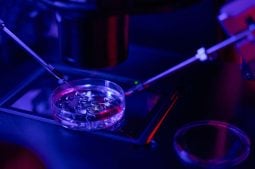
What’s the earliest you can take a pregnancy test? This is the first question many of our patients ask after blastocyst transfer, the culmination of the IVF treatment cycle. It’s completely understandable. After all, our patients have gone through a lot, emotionally and physically, to reach this stage. However, there are a few factors that make it more complicated for IVF patients than for other types of pregnancy.
In this article we will explain the reasons for this and why a pregnancy test after an IVF day 5 transfer, if taken too soon, could quite easily come up with a false result, whether that’s positive or negative. The same applies to a pregnancy test after an IVF frozen embryo transfer. The right time for when to do a pregnancy test after blastocyst transfer is when you can rely on the accuracy of the result. Let’s see what this means.
What is blastocyst transfer?
When you go through the process of In Vitro Fertilisation (IVF), blastocyst transfer is what feels like the end of the process. This isn’t the case, of course, since the end of the process is pregnancy. This does not actually take place until the embryo has implanted in the lining of your uterus. It doesn’t happen for a few days, whether you are about to be pregnant by natural means or with the assistance of IVF. These are the steps leading up to that exciting moment:
- You make two visits to our clinic, during which we confirm a diagnosis. We agree a recommended treatment and establish a personalized protocol.
- There follows a period of around 15 days duration. During this you receive ovarian stimulating hormonal treatment to encourage your ovaries to produce multiple eggs.
- When these have reached an adequate number and matured sufficiently, you are given an injection of the hormone Human Chorionic Gonadotropin (hCG) which triggers final maturing of the eggs.
- Exactly 36 hours later, egg retrieval takes place. The eggs are immediately fertilized in the laboratory, either through mixing with your partner’s or donor’s sperm or through Intracytoplasmic sperm injection (ICSI).
- The resulting embryos are closely monitored during the following five days. During this time, all being well, they develop to the blastocyst stage. This is the time when our embryologists can select the healthiest embryo for transfer to your womb. Any unused healthy embryos can be frozen and stored for future use if necessary.
It is impossible for you, or our fertility specialists, to know whether the embryo transfer will result in pregnancy. The chemical changes that happen in your body if you have become pregnant are not detectable through a pregnancy test until around 11 days later. This is usually the time lapse, although since all cases are different, it may be slightly shorter or longer. Our IVF specialist will let you know the exact timing to take a blood test. If this is positive, an ultrasound scan follows 20 days later. At this point the pregnancy is visible and a heartbeat detectable.
When to do a pregnancy test
Home pregnancy tests work by registering the presence of hCG in the urine. Blood tests also detect the presence of this hormone, which the embryo produces shortly after implantation. Its levels rise steadily throughout the first trimester and fall off through the remaining six months.
There is a potential problem with taking a premature pregnancy test after blastocyst transfer. Some of the hormones which you were given before retrieval of the eggs could still be circulating in your body, both in your bloodstream and urine. So, if you take a pregnancy test too soon after blastocyst transfer, a positive result could merely be reflecting the presence of hCG remaining from your treatment.
Conversely, a pregnancy test taken too soon may return a false negative because the blastocyst can take a few days to implant and another few before the resulting levels of hCG are sufficient to be detectable. Blood tests are more accurate. This is why we always ask you to attend your fertility clinic for a Beta hCG test to confirm your pregnancy.
The best time to take a pregnancy test
There are two aspects to this question as well. There’s the best time of the month, which is by far the most important, but there’s also the time of day to consider.
The best time of the monthly cycle
The usual advice is to wait until the day after your missed period and indeed for many people, a missed period is often the first sign that they may be pregnant. If you have a regular 28-day cycle, your period would be due on day 28 and so day 29 is the first day after your missed period. If you have an irregular cycle, or don’t keep track, take the test the day after what you estimate to be your longest cycle time.
There’s no certain guarantee about the first day of your missed period. It just happens to coincide, if you have a regular cycle, with 13 to 14 days after ovulation. Since a fertilised egg can take up to a week to implant in the uterus, and as the body only begins to produce hCG after implantation, these two weeks after ovulation are needed for hCG levels to increase to the point where they can be detected by the test. You can’t hurry mother nature! Or at least if you do, by taking the test too early, you may get a false negative result.
The best time of day
The best time of day to take a pregnancy test is first thing in the morning. This is because your urine is likely to be more concentrated at this time, and so it has the best chance of showing up the presence of hCG. Having said that, it’s not completely out of the question to take the test at other times in the day, particularly if you haven’t been drinking a lot so that your urine is not diluted.
How accurate are pregnancy tests?
In general, home pregnancy tests have a very high accuracy level, and because of the way that they work, a false positive is extremely unlikely. However, a false negative is more of a possibility, particularly on the day of or day after your missed period, because hCG levels could still be undetectably low. If you get a negative test but you ‘feel’ you might be pregnant, for example because of painful breasts or even morning sickness, it’s a good idea to take another test a week later.
Why do I need a blood test after IVF treatment?
When you are waiting to know whether you are pregnant following IVF treatment, it would not be a good idea to simply use a home testing kit. The reason you need to wait for two weeks following embryo transfer is the medication history. During the ovarian stimulation stage of the treatment, you will have been given an injection of hCG to trigger final maturation of the oocytes, 36 hours before retrieval of the eggs. The remains of the hCG could still be present in your body (and detectable in your urine) for some time afterwards. And that of course could invalidate the results of the home test. This is why, hard as it is, there’s no way around the
What about frozen embryo transfer?
We apply the same guidance and reasoning in the case of a pregnancy test after an IVF frozen embryo transfer. In this case, you will not have had the injection of hCG to trigger maturity and ovulation. Therefore, the likelihood of a false positive because the hormone is still circulating in your body is not so much of an issue. However, even though you have not been through the egg retrieval process and your embryos may have been in storage for a number of years, there is still a certain amount of medication involved in preparing your womb lining for reception of an embryo.
There is another factor to take into account in the case of frozen embryo transfer. This is that unlike fresh embryos which you could expect to implant within a day or two, it can take a few more days for frozen embryos, up to five days. Therefore in effect the same principles about pregnancy testing apply, though for slightly different reasons. The overall aim is to avoid the emotional distress caused by either a false positive or a false negative. You can be able to have complete confidence in the results.
Tips for getting through the two-week wait
We do understand how stressful it can be to have to wait those 11 days before having your blood test to confirm your pregnancy. It’s easier said than done to keep calm and carry on. We also know from experience that a false result can be even more distressing. So, stay as calm as you can, look after yourself. Remember that even if a single round of treatment turns out not to be successful, in most cases we can try again. In the meantime, why not browse our tips for dealing with IVF and the two-week wait?





Comments are closed here.